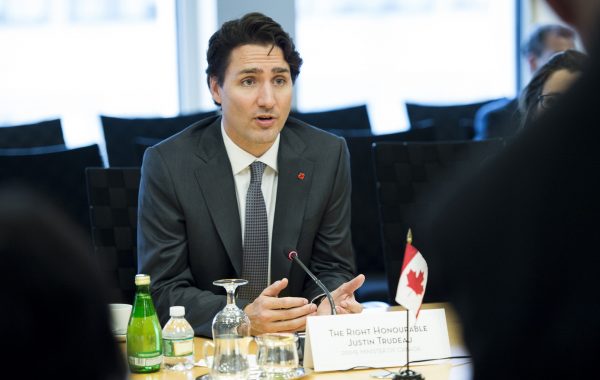The little explosion of sweaty news last week about an apparently buried federal report predicting “decades” of gigantic deficits added just a bit more fuel to the fire crackling around Justin Trudeau’s feet. The key take away was that net debt levels, driven by anemic GDP growth and an aging population, will crest at $1.55 trillion by the 2050s.
The short-hand media analysis focused more on that great big scary number than the complex political dynamic this analysis will set in motion.
I’m not talking about the short-term melodrama. The report obviously feeds into the emerging narrative of the Trudeau government as profligate and beholden to wealthy lobbying interests while increasingly isolated in a world that’s become fixated on the brain-stem appeal of nativist politics. It also gives Kevin O’Leary and the rest of the Conservative leadership pugilists a new talking point, allowing them to change the channel away from Kellie Leitch’s tone-deaf immigrant bashing.
Rather, when I scanned at this report, which is built on the sturdy and seemingly apolitical timber of long-term demographic and productivity analysis, two points struck me:
One, while the media reports presented the document as something the government released as quietly as a church mouse skittering around on Christmas eve, the language in the document bears the unmistakable signs of a political edit: “As this demographic transition unfolds,” the unnamed Department of Finance author states at one point, “the Government will continue to take smart decisions and make sound investments to build Canada’s economy of the future and create an economy that works for the middle class [emphasis added].”
These, clearly, are not the words of some nerdy government economist.
So? I’d argue this document was absolutely intended to be discovered, thus subtly sending the signal that Ottawa is keeping a watchful eye trained on long-term economic and spending trends.
And who is the real audience for this information? It’s not the opposition, nor the general public, but instead the Finance Department’s internal and external counterparties: various expensive ministries, provincial governments, and other recipients of federal largesse, including — although none of the analysis made this point explicitly — Canada’s municipalities, whose leaders still believe they’re poised to gobble up tens of billions in new infrastructure funding.
Which leads me to point two. The inherent weakness, as well as the implicit message, in such long-term deficit projections is that they’re true until they’re not true, which is to say, up to the moment when the political conditions align to force a response to curtail exponentially growing deficits, as happened in the mid-1990s.
And this is precisely where municipal leaders need to sit up and take careful notice of what exactly Ottawa is signaling with this piece of passive-aggressive messaging.
A bit of history is in order. After Brian Mulroney’s Conservatives failed to control the federal deficit in the late 1980s and early 1990s, Jean Chretien’s Liberals took power at a time when the economy was stalled and the far-right Reform Party was making huge gains in Western Canada.
When the Wall Street Journal predicted that Canada’s public finances were in such disarray that we’d soon be unable to sell our bonds in New York, finance minister Paul Martin aggressively began to eliminate the federal deficit, starting in 1995. His big move: re-jigging a federal transfer arrangement with the provinces, which, in turn, downloaded a whole host of operating burdens to the municipalities. In Ontario, that fiscal waterfall gained even more energy and momentum after Mike Harris came to power in 1995 promising both tax and spending cuts.
While all that played out over 20 years ago, here in Toronto, city council still grapples with the fall-out of Martin’s deficit battle: both the massive financial burden that is Toronto Community Housing and the severely curtailed capital and operating subsidies for transit dating back to the 1995-1998 period.
What the report says, to me, is that at some point in the foreseeable future, we’ll see a reprise (Martin: The Sequel!), with similar cascading consequences for revenue-starved municipalities still trying to figure out how to manage the after-shocks from the last round of federal deficit busting.
No one, of course, can predict when that moment arrives. Without explicitly trying to game out national politics, the Department of Finance analysis states that federal debt and deficit levels will only begin to climb to worrying levels in the early- to mid-2020s, which is to say, following the next federal election.
From where I sit, the dynamic of the mid-to-late 1990s may actually be reversed after 2018, with a new Patrick Brown government at Queen’s Park – yes, it will happen – firing the first shot with an aggressive cost-cutting and downloading agenda that forces the federal Liberals to respond. Likely, they’ll seek to demonstrate they can prevent the trillion-dollar debt-boogey man laid out in this analysis.
All of which brings to mind the tepid efforts by Toronto council to find new revenue tools to reduce the municipality’s reliance on property taxes and other regressive levies.
It’s hardly a stretch to describe the proposed road toll and whatever other levies council might green light this spring as little more than long-delayed, partial responses to the last round of federal downloading. These moves are much more about plugging old leaks than forward planning.
Despite the efforts of city manager Peter Wallace to push the city to proactively diversify its revenues, Mayor John Tory and many councillors still seem oblivious to the implications of a Brown victory in 2018, much less the more distant threats hinted at by the Finance Department’s pre-Christmas warning.
With this analysis, Ottawa has put every bureaucrat in the country, including those working for the City of Toronto, on notice: the fiscal taps will be turned off, perhaps sooner than they think.
We can pretend not to hear, or we can attempt to learn from the past and look for ways to avoid being sandbagged by some future finance minister. Up to us.






One comment
Agreed on plugging leaks, Toronto has used senior government grants and Land Transfer to keep property tax below inflation instead of investing to keep costs down in future eg poverty reduction that impacts so many other costs. Then there is the seniors tidal wave and the expectation for services . What is the response to pedestrian deaths, add a few signs. Toronto Council is running on a wing and prayer instead of getting a stable tax based stable budget with strategic investments to pay forward.
The political dynamic of expecting senior government to pay up when Toronto has not taxed or used it’s revenue tools has limited cache with senior government voters outside 416. Another fail.